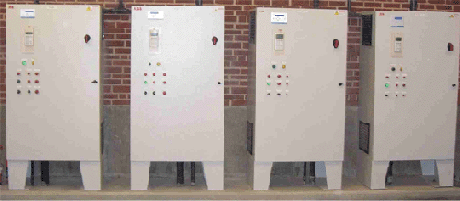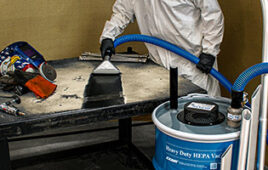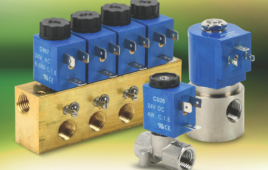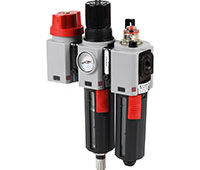July 2007 Design Notes
With 450 miles of sanitary sewer-collection lines and 33 lift stations that feed into a central wastewater treatment plant, the City of Lawrence, Kansas wastewater management system is extensive. Gravity drives wastewater distribution to the treatment plant, except where vertical elevation changes the topography. In these circumstances, lift stations– structures that contain pumps and controls– move wastewater to the treatment plant.
Because of ongoing increases in demand, Dave King, wastewater maintenance manager, City of Lawrence, continually looks for ways to improve efficiency. Lift station number 16, built in 1958, transports approximately 600 million gallons of dry weather-flow a year, about 25-30% of the city’s wastewater usage. Aging equipment and increasing flow from new residential developments led to the decision to retrofit the station completely in the spring of 2006. King turned to the city’s long-time PLC supplier, Logic, Inc. to handle the job.
Logic recommended installing ABB ACS800 drives on each of four new 125 hp pump motors to: increase efficiency and power factor to improve electricity cost savings; extend the life of the motors and reduce repair costs; and minimize or eliminate harmonics that can interfere with instrumentation and overheat feeder breakers and transformers.
When wastewater enters a lift station, it initially goes through a course screening process, which removes solid particles that could damage the pumps. The wastewater then flows into an enclosed wet well, which can be 30-40 feet deep. Sensors monitor the wastewater depth in the wet well. Pumps displace the wastewater from the well to the treatment facility. Drives are key in supporting the pump operation, ensuring that a constant flow is discharged to maintain optimum wastewater levels. Plus, the drives eliminate unnecessary pump starts.
Previously, the site ran the pumps based on an on/off level and used an across- the-line starter. When the level in the wet well reached a designated point, it triggered the starter to rev the motors up to maximum speed as quickly as possible. This rapid acceleration created spikes and mechanical stress on both the motor and pump. The motors ran at full speed until they reached the “off” level elevation. The constant-speed, starting-and-stopping process led to wear and tear on the bearings and impellers, causing the motors to deteriorate.
By maintaining a consistent level in the lift station wet well, drives also help to avoid water hammers. When a pump starts or stops suddenly, it slams the check value on the back of the pump and creates a “water hammer” effect. Water hammers are pressure surges caused by the energy of a fluid in motion when it is forced to stop abruptly. In a lift station, hydraulic water hammers often occur when trying to pump fluid vertically or at a slant. Once a pump stops, the fluid will come back to the source, jarring the piping. Over time, water hammers can deteriorate the pipe. The acceleration and de-acceleration ramp provided by the ACS800 reduces wear and tear on the pump mechanicals. The drive’s soft-start function gently ramps speed to limit potential turbulence and reduce maintenance. Sensors in the wet well communicate to a PLC at the lift station through DeviceNet. The PLC then relays commands to the drives. The wastewater treatment plant communicates with the PLC through Ethernet to ensure that wastewater levels are pumped out consistently based on established parameters. Although three pumps are needed to run the station, the city keeps an installed fourth pump on stand-by at all times, running them alternately to balance wear.
“With ABB drives, we can handle the range of variations in wastewater flow entering the station because of the time of day, time of year, and weather conditions, as well as the capacity to accommodate future growth,” says King. “We can now pump wastewater out at the same rate it enters, which reduces odors.”

The compact footprint of the ABB ACS 800
Ultra-low Harmonic Drives was a perfect fit in the lift station at the
City of Lawrence, Kansas wastewater facility.
Since wastewater is constantly running throughout the city, another important feature to the lift station is the by-pass function, which allows a manual override of the pump if a drive were to go offline. “Even though modern drives are very reliable, if for any reason we were to have multiple drive failures, the bypass gives us the ability to still operate the station,” explains King.
The lift station retrofit was not the first instance where the city has benefited from using ABB drives. The wastewater treatment facility also has ABB drives equipped with bypass to increase efficiency. The city is now installing ABB drives in four other wastewater pump stations currently under construction.


Here, one of the City of Lawrence engineers
executes a final testing and commissioning of ACS800 drives at the
wastewater lift station.
Ultra-low harmonic drives provide protection to power grids
Additionally, the lift station is located next to a residential district, so minimizing harmonic distortion is important. “Excessive harmonics can interfere with pump instrumentation,” King says. “Plus, we didn’t want to cause any interruption to the electrical appliances of our customers.”
Ultra-Low Harmonic (ULH) ACS800 drives do not require a multi-pulse transformer, external filters, or other additional equipment for minimizing harmonics. The drive features an active converter with Direct Torque Control (DTC) to eliminate low-order harmonics. With an active front-end LCL (Inductor, Capacitor, Inductor) line filter to reduce high frequency harmonics, the city did not have to worry about overheating feeder breakers or transformers.
DW ABB, Inc.
www.abb.com
Logic, Inc.
www.logic-control.com
:: Design World ::
Filed Under: Pumps, Drives (servo) + amplifiers, FLUID POWER





Tell Us What You Think!